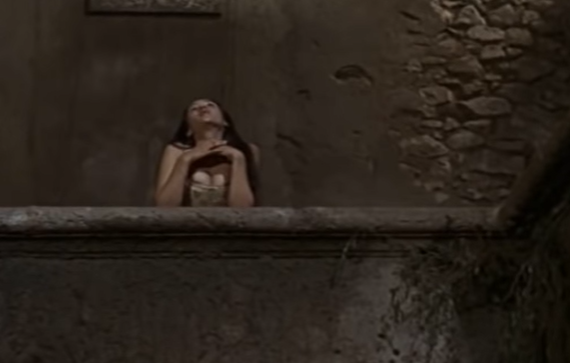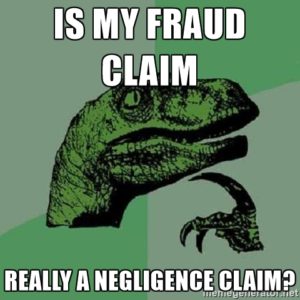Willow Tree Consulting Group LLC v. Perkins Coie LLP, discussed last week also addressed an argument that limitations had been tolled because a company’s outside counsel was involved with the “adverse domination” of the relevant company by insiders. The Fifth Court declined to apply this argument against a law firm based on alleged activity of a partner, reminding that “limited liability companies and partnerships are legally distinct from their members.” The Court further held that “True Health was dominated by its own officers and directors and Texas’ application of the doctrine has not been expanded beyond insiders.” No. 05-23-00264-CV (Feb. 13, 2024) (mem. op.).
Category Archives: Statute of Limitations
In Willow Tree Consulting Group LLC v. Perkins Coie LLP, the Fifth Court affirmed summary judgment on several claims against a law firm, holding, inter alia, that limitations began to run when the relevant Chief Compliance Officer, who “was both a coroprate agent and an innocent insider,” received a Civil Investigative Demand about matters related to the claims. No. 05-23-00264-CV (Feb. 13, 2024) (mem. op.).
 Reviewing its earlier precendent about a limitations-tolling statute, the Texas Supreme Court held in Ferrer v. Almanza that:
Reviewing its earlier precendent about a limitations-tolling statute, the Texas Supreme Court held in Ferrer v. Almanza that:
“Ashley held that “absence from this state” under [Tex. Civ. Prac. & Rem. Code ] Section 16.063 depends not on physical location but, rather, on whether a defendant is subject to personal jurisdiction and service. That holding applies to resident and nonresident defendants with equal force. If a defendant is subject to personal jurisdiction in Texas and amenable to service, he or she is not absent from Texas under Section 16.063, and Section 16.063 does not apply.”
No. 21-0513 (Tex. April 28, 2023). A dissent argued that the majority strayed too far from an appropriate focus on the statutory text.
 The Fifth Circuit and Texas Supreme Court both recently addressed limitations issues in commercial cases:
The Fifth Circuit and Texas Supreme Court both recently addressed limitations issues in commercial cases:
- Civelli v. JP Morgan Securities involved an investor’s claim that JP Morgan wrongly transferred certain shares of stock in an oil company. The Fifth Circuit declined to apply the discovery rule, stating: “Any injury incurred from the J.P. Morgan defendants’ alleged negligence in transferring the shares without plaintiffs’ consent arose at the time of the transfer. Because Civelli admits that he knew by February 2014 that they had transferred the funds, the rule of discovery does not apply.” No. 21-20618 (Jan. 11, 2023).
- Marcus & Millichap v. Triex Texas Holdings LLC was a suit against a real-estate broker about the sale of a gas station. The Texas Supreme Court held: “It is undisputed that Triex knew it was injured in December 2012. The question before us is whether the discovery rule defers accrual of Triex’s cause of action until it knew that Marcus & Millichap caused its injury. We hold that it does not.” No. 21-0913 (Jan. 13, 2023) (per curiam).
An unusual application of Hughes tolling appeared in White Nile Software v. Travis. The issue of who was entitled to act on behalf of a potential legal-malpractice client remained unresolved for a whopping seven years:
“Thus, rather than coming to a conclusion in 2011, White Nile’s legal malpractice claims in state court were in a legal limbo while Mandell’s bankruptcy proceedings continued, pending a final determination of authority or capacity to take action on behalf of White Nile … This issue was only resolved when the order of the bankruptcy court that Mandel had no shares in White Nile became final in October 2018.”
The Fifth Court concluded that this potential claims was tolled, quoting Hughes: “Where “a person is prevented from exercising his legal remedy by the pendency of legal proceedings, the time during which he is thus prevented should not be counted against him in determining whether limitations have barred his right.” No. 05-20-00354-CV (Aug. 29, 2022) (mem. op.).
The Fifth Court affirmed summary judgment for the defense in a sexual abuse case involving long-ago events, summarizing:
“We do not question the sincerity of Doe’s motive for bringing the lawsuit or the reality of the terrible ordeal he underwent at the hands of a person who should have protected him and while in the care of organizations dedicated to protecting children like himself. … . The purpose of the statute of limitations is to ‘protect defendants and the courts from having to deal with cases in which the search for truth may be seriously impaired by the loss of evidence, whether by death or disappearance of witnesses, fading memories, disappearance of documents or otherwise.’ The forty years between the assault and Doe’s bringing suit has taken a toll on the evidence available in this case as every person involved aside from Doe and G.L. appears to be deceased. The courts have created narrow exceptions to the application of the statute of limitations, including the discovery rule, fraudulent concealment, and equitable estoppel, but the evidence conclusively established those exceptions do not apply in this case and that Doe did not present evidence raising a genuine issue of material fact as to whether those exceptions apply.”
Doe v. Catholic Society, No. 05-21-00616-CV (June 30, 2022) (mem. op.).
 In Romeo and Juliet, the doomed heroine observes: “What’s in a name? That which we call a rose by any other name would smell as sweet.”
In Romeo and Juliet, the doomed heroine observes: “What’s in a name? That which we call a rose by any other name would smell as sweet.”
In Bell v. XTC Cabaret (Dallas), Inc., the Fifth Court observes (citations omitted):
“A misnomer differs from a misidentification. Misidentification—the consequences of which are generally harsh—arises when two separate legal entities exist and a plaintiff mistakenly sues an entity with a name similar to that of the correct entity. If a plaintiff is mistaken as to which of two defendants is the correct one and there is actually existing a corporation with the name of the erroneously named defendant (misidentification), then the plaintiff has sued the wrong party and limitations is not tolled.”
Those principles did not save a lawsuit filed against the wrong “XTC” entity: “Appellants argue the doctrine of misnomer applies because they served the correct defendant, XTC Cabaret (Dallas), Inc., but misnamed it as XTC Cabaret, Inc. … The fact that businesses have the same registered agent and the same attorneys is not evidence that they were aware of whom appellants intended to sue. We conclude appellants have not shown that the doctrine of misnomer applies.” No. 05-21-00294-CV (May 5, 2022) (mem. op.).
Prime argued that fraudulent inducement tolled limitations on its fraud claims, citing an email in which the defendant said: “I ask that you extend this [deadline] to at least 90 days or some other requirement so we have the chance to find another investor, do the paperwork, and get his funding.” The Fifth Court disagreed, stating that the “request to extend the time to ninety days by itself is simply not a representation, promise, or an agreement that would extend the accrual of a cause of action.” Prime United Petroleum Holding Co., LLC v. Malameel, LLC, No. 05-20-00032-CV (Aug. 24, 2021) (mem. op.) (emphasis in original).
Continuing to drive home the point from the recent Glassdoor litigation, the Fifth Court again reminded that: “Because the limitations period had run on the Estate’s anticipated claims before it filed its Rule 202 petition, the petition was moot, and the trial court should have dismissed the petition for want of jurisdiction.” In re Estate of Tobolowsky, No. 05-19-00073-CV (Oct. 20, 2020) (mem. op.).
 Evans v. Martinez arose from a jury trial as to whether reasonable diligence had been used in serving a defendant, against whom suit had been filed on the last day of the limitations period. The jury answered “no” and the Fifth Court affirmed the resulting judgment: “Here, the return of service recites that the process server first came into possession of the citation on October 27, 2015, more than a month after limitations expired. Although Weinkauf offered some evidence regarding the delay, he did not explain why, when he knew he had filed suit on the last day of limitations and that he would shortly leave on vacation, he did not make an alternative arrangement to ensure that the effort to serve Martinez would begin in his absence. On his return, he left the citation sitting at his reception desk and checked on it only once a week even after problems arose with his arrangements for service. There is no evidence to support his testimony of the efforts he made, such as phone records, notes, emails, or testimony from support staff or process servers.” No. 05-18-01241-CV (April 20, 2020) (mem. op.)
Evans v. Martinez arose from a jury trial as to whether reasonable diligence had been used in serving a defendant, against whom suit had been filed on the last day of the limitations period. The jury answered “no” and the Fifth Court affirmed the resulting judgment: “Here, the return of service recites that the process server first came into possession of the citation on October 27, 2015, more than a month after limitations expired. Although Weinkauf offered some evidence regarding the delay, he did not explain why, when he knew he had filed suit on the last day of limitations and that he would shortly leave on vacation, he did not make an alternative arrangement to ensure that the effort to serve Martinez would begin in his absence. On his return, he left the citation sitting at his reception desk and checked on it only once a week even after problems arose with his arrangements for service. There is no evidence to support his testimony of the efforts he made, such as phone records, notes, emails, or testimony from support staff or process servers.” No. 05-18-01241-CV (April 20, 2020) (mem. op.)
 “Appellants argue, with some logical force, that the ‘tolling’of limitations in a fraudulent concealment case involving silence by a physician and hospital does not end when the patient is discharged from the hospital or at the patient’s last visit to a physician, but instead ‘runs until the plaintiff discovers the fraud or reasonabl[y] could discover the fraud.’ This is so, they say, because limitations naturally runs from the date of last treatment, so fraudulent concealment estoppel provides no additional benefit to plaintiffs like them. Unfortunately, appellants cite no authority for that proposition and we have found none.When appellants’ relationships with Dr. Courtney and Baylor Frisco terminated, so did those health care providers’ duty to disclose. Thus, the statute of limitations as to Dr. Courtney and Baylor Frisco began to run at that time.” Tarrant v. Baylor Scott & White Med. Center-Frisco, No. 05-18-01129-CV (Jan. 15, 2020) (mem. op.) (emphasis added, citations omitted).
“Appellants argue, with some logical force, that the ‘tolling’of limitations in a fraudulent concealment case involving silence by a physician and hospital does not end when the patient is discharged from the hospital or at the patient’s last visit to a physician, but instead ‘runs until the plaintiff discovers the fraud or reasonabl[y] could discover the fraud.’ This is so, they say, because limitations naturally runs from the date of last treatment, so fraudulent concealment estoppel provides no additional benefit to plaintiffs like them. Unfortunately, appellants cite no authority for that proposition and we have found none.When appellants’ relationships with Dr. Courtney and Baylor Frisco terminated, so did those health care providers’ duty to disclose. Thus, the statute of limitations as to Dr. Courtney and Baylor Frisco began to run at that time.” Tarrant v. Baylor Scott & White Med. Center-Frisco, No. 05-18-01129-CV (Jan. 15, 2020) (mem. op.) (emphasis added, citations omitted).
 Denny successfully sued Chang for medical malpractice, based on a cotton ball left inside her head after brain surgery. The key appellate issue was a jury question about Denny’s “degree of diligence” in bringing suit – a finding needed to support her open courts counter-defense to the two-year statute of limitations on her claim. The majority opinion first found waiver about an objection to the form of the question, and then found that sufficient evidence supported the jury’s finding, noting testimony about her difficulty in finding a treating physician who did not “fear[] they were going to be dragged into litigation,” and that her health problems precluded her from meeting with counsel for substantial periods of time. Chang v. Denny, No. 05-17-01457-CV (Aug. 23, 2019) (mem. op.).
Denny successfully sued Chang for medical malpractice, based on a cotton ball left inside her head after brain surgery. The key appellate issue was a jury question about Denny’s “degree of diligence” in bringing suit – a finding needed to support her open courts counter-defense to the two-year statute of limitations on her claim. The majority opinion first found waiver about an objection to the form of the question, and then found that sufficient evidence supported the jury’s finding, noting testimony about her difficulty in finding a treating physician who did not “fear[] they were going to be dragged into litigation,” and that her health problems precluded her from meeting with counsel for substantial periods of time. Chang v. Denny, No. 05-17-01457-CV (Aug. 23, 2019) (mem. op.).
A dissent criticized the treatment of this issue as one of fact, warning of it “disappearing into the amorphous slurry of jury deliberations,” and that “the misunderstandings and inaction of her legal counsel” were to blame for the delay. Underlying the dissent was concern as to “why the Legislature has remained silent for the past 18 years” since the Texas Supreme Court first connected Texas’s open-courts guarantee to an inherently undiscoverable medical injury in Shah v. Moss, 67 S.W.3d 836 (Tex. 2001).
The How ards argued that their note was not a negotiable instrument (and thus, not subject to a 6-year statute of limitations), citing provisions in the note about late fees, notice obligations, and a usury savings clause. While under the UCC, an instrument can become non-negotiatble if it includes “any other undertaking or instruction by the person promising or ordering payment to do any act in addition to the payment of money,” these provisions were permissible as “an undertaking or power to give, maintain, or protect collateral to secure payment.” PNC v. Howard, No. 05-17-01484-CV (June 24, 2019) (applying TBOC § 3.104(a)).
ards argued that their note was not a negotiable instrument (and thus, not subject to a 6-year statute of limitations), citing provisions in the note about late fees, notice obligations, and a usury savings clause. While under the UCC, an instrument can become non-negotiatble if it includes “any other undertaking or instruction by the person promising or ordering payment to do any act in addition to the payment of money,” these provisions were permissible as “an undertaking or power to give, maintain, or protect collateral to secure payment.” PNC v. Howard, No. 05-17-01484-CV (June 24, 2019) (applying TBOC § 3.104(a)).
 A claim accrues when a wrongful act causes injury; if multiple wrongful acts occur, they may — or, may not — cause multiple injuries. Uncertainty on that point led to reversal of a summary judgment on limitations in Inman v. Loe: “In summary, to be entitled to final summary judgment, appellees had to prove conclusively that Inman’s contract and fiduciary breac h claims accrued more than four years before March 19, 2014. They relied on evidence showing that Inman was excluded from the company’s management and operation in June 2009. But Inman produced evidence that appellees committed other allegedly actionable conduct in August 2010, and nothing establishes that these acts did not result in a legal injury distinct from any injury Inman may have suffered in 2009.” No. 05-18-00130-CV (Feb. 20, 2019) (mem. op.)
A claim accrues when a wrongful act causes injury; if multiple wrongful acts occur, they may — or, may not — cause multiple injuries. Uncertainty on that point led to reversal of a summary judgment on limitations in Inman v. Loe: “In summary, to be entitled to final summary judgment, appellees had to prove conclusively that Inman’s contract and fiduciary breac h claims accrued more than four years before March 19, 2014. They relied on evidence showing that Inman was excluded from the company’s management and operation in June 2009. But Inman produced evidence that appellees committed other allegedly actionable conduct in August 2010, and nothing establishes that these acts did not result in a legal injury distinct from any injury Inman may have suffered in 2009.” No. 05-18-00130-CV (Feb. 20, 2019) (mem. op.)
 The Taylors argued that their medical malpractice case against UT-Southwestern was timely filed, even though they erroneously filed it against the University of Texas System, relying on the doctrine of “misidentification.” While suing the wrong party does not ordinarily toll
The Taylors argued that their medical malpractice case against UT-Southwestern was timely filed, even though they erroneously filed it against the University of Texas System, relying on the doctrine of “misidentification.” While suing the wrong party does not ordinarily toll  limitations, it can “if there are two separate, but related, entities that use a similar trade name and the correct entity had notice of the suit and was not misled of disadvantaged by the mistake.” The Fifth Court concluded that “University of Texas Southwestern Medical Center” and “University of Texas System” were not sufficiently similar to invoke this doctrine; additionally, the Taylors did not establish UTSW’s knowledge of the suit or a lack of prejudice to it. The opinion also addresses, and rejects, the related doctrine of “misnomer.” UT-Southwestern v. Taylor, No. 05-17-01221-CV (July 6, 2018).
limitations, it can “if there are two separate, but related, entities that use a similar trade name and the correct entity had notice of the suit and was not misled of disadvantaged by the mistake.” The Fifth Court concluded that “University of Texas Southwestern Medical Center” and “University of Texas System” were not sufficiently similar to invoke this doctrine; additionally, the Taylors did not establish UTSW’s knowledge of the suit or a lack of prejudice to it. The opinion also addresses, and rejects, the related doctrine of “misnomer.” UT-Southwestern v. Taylor, No. 05-17-01221-CV (July 6, 2018).
 In BB&T v. SWIG Partners LP, the Fifth Court reversed a limitations ruling based on allegedly inadequate efforts to serve all of the defendants, observing: “Twelve of the thirty named defendants were served within three weeks after citations were issued. All the defendants then made an appearance obviating the need for further service of process. See Tex. R. Civ. P. 120. The longest period of time without service on a defendant before all the defendants answered was four business days. The time between the date suit was filed and the date all defendants filed their original answer was twenty-eight days. When three of the defendants were omitted from the defendants’ amended answer, BB&T moved for substitute service. In granting BB&T’s motions for substitute service, the trial court repeatedly found BB&T had diligently attempted service on each of the subject defendants.” No. 05-15-00878-CV (Dec. 13, 2017) (mem. op.)
In BB&T v. SWIG Partners LP, the Fifth Court reversed a limitations ruling based on allegedly inadequate efforts to serve all of the defendants, observing: “Twelve of the thirty named defendants were served within three weeks after citations were issued. All the defendants then made an appearance obviating the need for further service of process. See Tex. R. Civ. P. 120. The longest period of time without service on a defendant before all the defendants answered was four business days. The time between the date suit was filed and the date all defendants filed their original answer was twenty-eight days. When three of the defendants were omitted from the defendants’ amended answer, BB&T moved for substitute service. In granting BB&T’s motions for substitute service, the trial court repeatedly found BB&T had diligently attempted service on each of the subject defendants.” No. 05-15-00878-CV (Dec. 13, 2017) (mem. op.)
In Teel v. Sumrow, the Fifth Court reversed and rendered judgment for the defense in a suit for breach of fiduciary duty, finding that limitations had run on the claim as a matter of law. “[W]e note that the letter  Sumrow wrote to Dr. Bray in July 2008 indicates that by that time, Sumrow knew or suspected Teel had engaged in some wrongful conduct to wrongfully deprive Sumrow of money Sumrow believed Teel owed him (‘screw me out of my money’).” As for reasonable diligence, the Court observed: “[I]n financial affairs, many citizens take a good deal on faith – not everyone zealously checks his mail every day or his bank statement every month – but it would not require ‘daily’ or even monthly diligence to discover the injury alleged in this case.” No. 05-16-00840-CV (Nov. 13, 2017) (mem. op.)
Sumrow wrote to Dr. Bray in July 2008 indicates that by that time, Sumrow knew or suspected Teel had engaged in some wrongful conduct to wrongfully deprive Sumrow of money Sumrow believed Teel owed him (‘screw me out of my money’).” As for reasonable diligence, the Court observed: “[I]n financial affairs, many citizens take a good deal on faith – not everyone zealously checks his mail every day or his bank statement every month – but it would not require ‘daily’ or even monthly diligence to discover the injury alleged in this case.” No. 05-16-00840-CV (Nov. 13, 2017) (mem. op.)
 Chase Bank sued a borrower; the threshold question was whether the longer limitations period for a negotiable instrument applied. While Chase sued on a note, the instrument did not qualify as a negotiable instrument because ” the sum-certain requirement is not met unless one can determine from the face of the note the extent of the maker’s liability.” Here, the Note (1) referred to a promise to pay “the total principal amount of $169,573.72 or so much as may be outstanding,” (2) “permit to pay ‘all or any part of the loan evidenced by this Note at any time,'” (3) said that “if prepayments are made, the Bank may apply them “in such order and manner as [the Bank] may from time to time determine in its sole discretion,'” and (4) referred to the “books and records of the Bank” to specify the precise amount owerd. Accordingly: “[b]ecause the Note fails to identify a sum certain on its face, we conclude it is not a negotiable instrument.” JP Morgan Chase v. Robinson & Hoskins, No. 05-17-00087-CV (Oct. 9, 2017) (mem. op.)
Chase Bank sued a borrower; the threshold question was whether the longer limitations period for a negotiable instrument applied. While Chase sued on a note, the instrument did not qualify as a negotiable instrument because ” the sum-certain requirement is not met unless one can determine from the face of the note the extent of the maker’s liability.” Here, the Note (1) referred to a promise to pay “the total principal amount of $169,573.72 or so much as may be outstanding,” (2) “permit to pay ‘all or any part of the loan evidenced by this Note at any time,'” (3) said that “if prepayments are made, the Bank may apply them “in such order and manner as [the Bank] may from time to time determine in its sole discretion,'” and (4) referred to the “books and records of the Bank” to specify the precise amount owerd. Accordingly: “[b]ecause the Note fails to identify a sum certain on its face, we conclude it is not a negotiable instrument.” JP Morgan Chase v. Robinson & Hoskins, No. 05-17-00087-CV (Oct. 9, 2017) (mem. op.)
 Brooks sued CalAtlantic about the construction of a retaining wall; CalAtlantic argued that the suit was barred by the 10-year statute of repose in Tex. Civ. Prac. & Rem. Code § 16.069. The Fifth Court affirmed summary judgment for the defense. Procedurally, the Court concluded that the plaintiff had the burden to establish an exception to the statute once the defendant showed its applicability, citing Ryland Group v. Hood, 924 S.W.2d 120 (Tex, 1996). Substantively, the Court distinguished plaintiff’s authority, observingL “[T]here is no evidence of [defendant’s] awareness that deviating from the Civil Plans could create property defects and dangerous conditions. And neither [cited case] supports Brooks’s contention that proof of deviation from construction plans, alone, is evidence of willful misconduct.” Brooks v. CalAtlantic Homes of Texas, No. 05-16-01203-CV (Oct. 9, 2017) (mem. op.)
Brooks sued CalAtlantic about the construction of a retaining wall; CalAtlantic argued that the suit was barred by the 10-year statute of repose in Tex. Civ. Prac. & Rem. Code § 16.069. The Fifth Court affirmed summary judgment for the defense. Procedurally, the Court concluded that the plaintiff had the burden to establish an exception to the statute once the defendant showed its applicability, citing Ryland Group v. Hood, 924 S.W.2d 120 (Tex, 1996). Substantively, the Court distinguished plaintiff’s authority, observingL “[T]here is no evidence of [defendant’s] awareness that deviating from the Civil Plans could create property defects and dangerous conditions. And neither [cited case] supports Brooks’s contention that proof of deviation from construction plans, alone, is evidence of willful misconduct.” Brooks v. CalAtlantic Homes of Texas, No. 05-16-01203-CV (Oct. 9, 2017) (mem. op.)
When is a fraud claim subject to a 2-year limitations period? When it’s not a fraud claim.
January 25, 2017In Parsons v. Queenan, et al., No. 05-15-01375-CV (January 23, 2017), the Dallas Court of Appeals affirmed summary judgment in favor of the defendants on limitations grounds. The suit was Parsons’ third in a series of malpractice suits against different attorneys that represented him since the death of his wife in a plane crash more than two decades earlier.
The first issue was whether the breach of fiduciary duty and fraud claims were subject to a 2-year statute of limitations for negligence or a 4-year statute of limitations for fraud or breach of fiduciary duty. The Dallas Court held that the 2-year limitations period applied under the anti-fracturing rule, which prevents legal malpractice plaintiffs from “opportunistically transforming a claim that sounds only in negligence into other claims” to avail themselves of longer limitations periods, less onerous proof requirements, or other tactical advantages. For the anti-fracturing rule to apply, the gravamen of the complaint must focus on the quality or adequacy of the attorney’s representation. The Dallas Court concluded that the fraud and breach of fiduciary duty claims asserted by Parsons were claims for professional negligence as a matter of law.
In the second issue, the Dallas Court held that the 2-year limitations period began to run on the date of the denial of the motion for reconsideration by the Texas Supreme Court in the underlying litigation, not the date mandate was issued. Under Hughes v. Mahaney & Higgins, 821 S.W.2d 154 (Tex. 1991), “the statute of limitations on the malpractice claim against the attorney is tolled until all appeals on the underlying claim are exhausted.” Id. at 157. The Dallas Court held that appeals are exhausted when a motion for rehearing with the Texas Supreme Court is denied because that is the last action of right that can be taken in the underlying case.
Parsons v. Queenan, et al., No. 05-15-01375-CV (January 23, 2017)
 If ever a case illustrated a trap for the unwary, it is IDA Engineering v. PBK Architects, in which the plaintiff sued exactly four years after the termination of its contractual relationship. Unfortunately, the invoices upon which its damage claim relied were issued before the contract termination, and the contracts contained this language about payment: “Invoices will be issued monthly, per
If ever a case illustrated a trap for the unwary, it is IDA Engineering v. PBK Architects, in which the plaintiff sued exactly four years after the termination of its contractual relationship. Unfortunately, the invoices upon which its damage claim relied were issued before the contract termination, and the contracts contained this language about payment: “Invoices will be issued monthly, per  percentage of completion or per phase and will be due upon issuance date.” (emphasis added). Accordingly, the claim was barred by limitations. No. 05-15-01418-CV (Oct. 4, 2016) (mem. op.)
percentage of completion or per phase and will be due upon issuance date.” (emphasis added). Accordingly, the claim was barred by limitations. No. 05-15-01418-CV (Oct. 4, 2016) (mem. op.)
In J.A. Green Development Corp. v. Grant Thornton, LLP, et al., the Dallas Court of Appeals held that limitations begin to run for claims arising from professional negligence in an IRS administrative proceeding as soon as the client learns the IRS disagrees with the advice.
The allegations were that Green hired Grant Thornton and Akin Gump in an IRS audit concerning Green’s participation in a “distressed debt strategy” that was sold to Green by prior advisors. Green alleged that Grant Thornton and Akin Gump told Green that the strategy was likely to be upheld as legal, causing Green to reject a settlement offer by the IRS. In December 2008, the IRS disagreed and issued a report disallowing the loss and imposing substantial penalties. Green alleged that Grant Thornton and Akin Gump then backed away from their prior advice. Six months later, Green sued the original advisors who sold it the tax strategy, but Green continued to retain Grant Thornton and Akin Gump to handle the appeal of the IRS decision. When it later became clear the appeal of the IRS decision would go poorly, Green settled with the IRS for more than the offer it rejected. It then sued Grant Thornton and Akin Gump.
The Dallas Court of Appeals affirmed summary judgment in favor of the defendants. The question was whether limitations started running in December 2008, when the IRS issued its first report indicating that the loss would be disallowed, or in November 2009, when it became clear the appeal of the IRS decision would fail. “[A] cause of action accrues when a wrongful act causes some legal injury, even if the fact of injury is not discovered until later, and even if all resulting damages have not yet occurred.” Green had to concede that it was first injured when it was sold the tax strategy because it had sued the promoters of the strategy before the administrative appeal failed. Green claimed the injury caused by Grant Thornton and Akin Gump was distinct from that caused by the original advisors, but the Court of Appeals held that Green suffered a single continuous injury that Green knew of when it received the IRS report disallowing the claimed loss. The Court of Appeals also held that the Hughes Tolling Rule, which tolls limitations in legal malpractice cases arising from litigation until the litigation is resolved, does not apply to administrative proceedings.
Congratulations to 600commerce’s own David S. Coale, who argued the case on appeal for Akin Gump, and to Trey Cox and Chris Patton, who were trial counsel.
Court closed to survivor and wrongful death claims: Claims arising from young girl’s death were already barred by limitations months before her death.
April 27, 2016In Durham v. Children’s Medical Center of Dallas, the Dallas Court of Appeals decided an issue of first impression: If a 12-year-old receives medical treatment and dies more than two years after that treatment because of the negligence of the health care providers, does the Texas Constitution’s Open Courts Clause prevent the running of limitations for survival and wrongful death claims? The Dallas Court of Appeals concluded that the answer is no because the Open Courts Clause does not apply to statutorily created claims.
The facts are plainly tragic. A 12-year-old girl was injured in a car accident in Hawaii. During treatment, the doctors also diagnosed a dilation of the ascending aorta, which apparently was not related to the accident itself. The doctors recommended a follow-up with a cardiologist. The girl was transferred to Children’s Medical Center of Dallas for a short time before then being transferred to Scottish Rite, where she was treated for her injuries resulting from the accident. Unfortunately, there was not a follow-up on the information about her enlarged aorta. A little more than two years later, the girl died because her aorta ruptured. She was only 15 years old. The girl’s mother and the administrator of her estate brought wrongful death and survival claims. Summary judgment was granted based on the 2-year statute of limitations.
The Dallas Court of Appeals affirmed. It held that Civil Practice and Remedies Code § 74.251 applied, which requires claims to be filed within 2 years of the treatment that is the subject of the claim unless the child is younger than 12. Because the girl was 12 at the time of treatment, the exception did not apply and limitations began to run on the date of treatment for statutory causes of action, including wrongful death and survival claims. The Court then distinguished the Texas Supreme Court’s decision in Weiner v. Wasson, which held that limitations are unconstitutional as applied to minors under the Open Courts Clause of the Texas Constitution because they would cut off the minor’s cause of action before he reaches majority. The Dallas Court of Appeals held that the Open Courts Clause and Weiner v. Wasson could not save the survival and wrongful death claims because the Open Courts Clause does not apply to statutory claims, which include survival and wrongful death claims. As a result, the survival and wrongful death claims arising from the girl’s death were already barred by limitations months before her death.
Plaintiffs sought damages for losing a telecommunication contract with DISD. The defendants argued that, in the absence of any evidence of acts of fraudulent concealment, limitations should run from 2006 when Plaintiffs received their last payment. The Fifth Court agreed, rejecting Plaintiffs’ counterargument that limitations did not begin to run until the federal agency overseeing the contract had completed its investigation of the situation. Lazo Technologies v. Hewlett-Packard, No. 05-14-01060-CV (Jan. 7, 2016) (mem. op.)
 The Hales sued their homebuilder for fraud and violation of the DTPA, alleging serious problems with the foundation of their Rockwall home (right). They substantially succeeded at trial, and the Dallas Court of Appeals affirmed in large part in Bishop Abbey Homes, Ltd. v. Hale, No. 05-14-00137-CV (Dec. 16, 2015) (mem. op.) In particular, the Court affirmed as to limitations – a significant issue in this long-simmering dispute – noting that “each time the Hales raised a concern about the foundation, they were assured by one of appellants’ experts that the foundation was not the cause of the problems the Hales observed.” The court also affirmed as to sufficiency challenges to liability, several claims of improper closing argument, and a challenge to the the basis of the exemplary damages award based on constitutional and Kraus factors. The court requested a remittitur as to (a) mental anguish damages (for sufficiency reasons) above $208,856 per plaintiff; and (b) a portion of the additional/exemplary damages award, based on the applicable cap and the conclusion that the total award “exceeds the guidelines set forth in [Bennett v. Reynolds, 315 S.W.3d 867 (Tex. 2010)] and [Tony Gullo Motors I, LP v. Chapa, 212 S.W.3d 299 (Tex. 2006)] for the type of harm suffered by the Hales as a result of appellants’ conduct.”
The Hales sued their homebuilder for fraud and violation of the DTPA, alleging serious problems with the foundation of their Rockwall home (right). They substantially succeeded at trial, and the Dallas Court of Appeals affirmed in large part in Bishop Abbey Homes, Ltd. v. Hale, No. 05-14-00137-CV (Dec. 16, 2015) (mem. op.) In particular, the Court affirmed as to limitations – a significant issue in this long-simmering dispute – noting that “each time the Hales raised a concern about the foundation, they were assured by one of appellants’ experts that the foundation was not the cause of the problems the Hales observed.” The court also affirmed as to sufficiency challenges to liability, several claims of improper closing argument, and a challenge to the the basis of the exemplary damages award based on constitutional and Kraus factors. The court requested a remittitur as to (a) mental anguish damages (for sufficiency reasons) above $208,856 per plaintiff; and (b) a portion of the additional/exemplary damages award, based on the applicable cap and the conclusion that the total award “exceeds the guidelines set forth in [Bennett v. Reynolds, 315 S.W.3d 867 (Tex. 2010)] and [Tony Gullo Motors I, LP v. Chapa, 212 S.W.3d 299 (Tex. 2006)] for the type of harm suffered by the Hales as a result of appellants’ conduct.”
Clyde Parks signed a $10,000 promissory note, bearing 15% interest and secured by Super Bowl tickets, in favor of Scott Seybold. Parks defaulted on the note, but did make some sporadic payments before limitations expired. When Seybold demanded payment after the limitations period had expired, Parks responded with emails stating that he was working to get the note paid and that he was not ignoring it. That was enough for both the trial court and the Dallas Court of Appeals to conclude that the claim was not barred by limitations, because the debtor had acknowledged the debt, in writing, as a current obligation. See Tex. Civ. Prac. & Rem. Code § 16.065. The Court of Appeals rejected Parks’ argument that he had not “signed” the emails pursuant to the Texas Uniform Electronic Transactions Act, affirming the trial court’s finding that the “Thank you, Clyde” salutation in each email was intended to be Parks’ signature. Notably, the Court of Appeals pointed out that it was expressing no opinion on whether the automatically-generated name and contact information block at the end of each email could constitute an electronic signature.
Parks v. Seybold, No. 05-13-00694-CV
In this action for negligent appraisal, the Court of Appeals found that the two-year statute of limitations for negligence actions had not been tolled by the discovery rule because the homebuyer knew, before closing, of information indicating the value of the property was much less than what he had offered to pay for it. Specifically, the appraiser had indicated that the house was worth $295,000 (or $10,000 less than what the plaintiff had offered to pay for it). More importantly, Zillow.com showed that the property was $100,000 less than what the buyer had offered. Despite these two indications that should cause a reasonable person to investigate further, the plaintiff did not bring suit until three years later, when he had hired another appraiser to provide an estimate of the property’s value and found out that the property was, in fact, worth much less than he had paid.
In this suit to collect on a promissory note, the Court of Appeals found that the six-year statute of limitations to sue on a “negotiable instrument” did not apply because the note at issue was not, in fact, negotiable. According to the Court, because the note represented a revolving line-of-credit, permitting the borrower to prepay all or any portion of the amount due without incurring any prepayment penalty, the note did not contain an unconditional promise to pay a sum certain for a fixed amount and was therefore non-negotiable. Thus, the Court found that the six-year statute of limitations for negotiable instruments did not apply and affirmed the trial court’s decision.
Bank of Am., N.A. v. Alta Logistics, Inc.
In this car accident case, the defendant moved for summary judgment on statute of limitations grounds. While the plaintiff claimed that a typo in the original petition precluded the process server from locating the defendant before the limitations period expired, the Court of Appeals found that the plaintiff had no explanation for the delay in serving the defendant because the defendant’s correct address, telephone number, driver’s license number, and license plane number were available in the police report describing the accident that is the basis for the lawsuit.
In this breach of contract action, the Court of Appeals held that Texas’ four-year statute of limitations barred the defendant’s counterclaim. The breach of contract counterclaim was based on the plaintiff’s failure to provide account documents within 10 days of the date of the agreement, which was June 28, 2007. Because the defendant made no legal argument to toll the date of the agreement, the Court held that all of the defendant’s claims under the agreement at issue were barred as a matter of law.
In this negligent misrepresentation case, Guarantee Company of North America sued Weaver and Tidwell LLP for issuing negligent audit reports on which Guarantee relied when issuing performance bonds. The central issue on appeal was whether the two-year statute of limitations for negligent misrepresentation actions barred Guarantee’s claim. The Court held that “a person suffers legal injury from faulty professional advice when the advice is taken.” Thus, the claim in this suit accrued as soon as Weaver’s alleged misrepresentation induced Guarantee to act; that is, when Guarantee issued its first bond in reliance on the faulty audit, which was more than two years before it filed suit. While Guarantee argued that the discovery rule applied to toll the statute of limitations, the Court refused to apply the discovery rule here because Guarantee did not obtain findings on when it knew or should have known of the facts that gave rise to its cause of action.
What, you may be asking yourself, is a viatical settlement? A new securities opinion from the Dallas Court of Appeals provides the answer to that question, and in the process examines the scope of the Texas Securities Act. Life Partners, Inc. is in the business of buying life insurance policies and reselling interests in those policies to investors, transactions known as “life settlements” or “viatical settlements.” The purchasers of those policies are not told what Life Partners paid for them, and Life Partners remains the owner of the policies while holding them as the agent for the investors. Several of the company’s investors filed suit for violations of the TSA, alleging that the life settlements were actually investment contracts that qualified as securities under the TSA. The trial court court granted summary judgment for Life Partners.
The case turned on the question of whether the profits sought by the investors of these viatical settlements were derived “solely from the efforts of others,” one of the four factors for determining whether investment contracts qualify as securities under SEC v. W.J. Howey Co., 328 U.S.293 (1946) and Searsy v. Commercial Trading Corp., 560 S.W.2d 637 (Tex. 1977). After a detailed analysis of a line of cases holding that viatical settlements were not securities, the Court disagreed. Because the investors were dependent upon Life Investors for the evaluation and purchase of the policies, and because they were also required to rely on Life Investors for information about the insureds, the profits were indeed derived solely from the efforts of Life Partners. In so holding, the Court expressly disagreed with the Waco Court of Appeals, which had reached the opposite conclusion in a previous case, and instead followed rulings by the 11th Circuit, the Tyler Court of Appeals, and several courts in other states. In doing so, the Court rejected Life Partners’ argument that it was engaged in the business of selling insurance, which is exempted from regulation by the TSA. Finally, the Court determined that while the claims of the two lead plaintiffs were barred by limitations, some of the claims of two other plaintiffs had been timely filed and could proceed on remand to the trial court.
Given the split of authorities, this case would seem to be a candidate for review by the Texas Supreme Court. We’ll keep you updated if it proceeds in that direction.
Arnold v. Life Partners, Inc., No. 05-12-00092-CV
The district court granted summary judgment in favor of the defendant in a car wreck case. The defendant sought summary judgment based on the 2-year statute of limitations for personal injury and the plaintiff’s alleged lack of diligence in serving the petition. The accident had happened on April 24, 2009, but the plaintiff’s petition had not been filed until April 25, 2011. The Court of Appeals reversed, holding that the summary judgment evidence was sufficient to show the petition was timely filed because the court had been closed for Good Friday when the plaintiff attempted to file it on April 22. See Tex Civ. Prac. & Rem. Code § 16.003(a). The defendant had also failed to submit any summary judgment evidence showing that he had not been timely served, thereby failing to meet his own burden to establish the plaintiff’s lack of due diligence in serving the citation after the limitations period expired.
Sutton v. Sheikh, No. 05-12-01168-CV
In August 2002, after Kroupa and WIlliams had been living together in a common law marriage for a number of years, Williams took out a home equity loan on the parties’ residence without telling Kroupa. Kroupa discovered the home equity loan the following month, in September 2002. Several years passed, and Kroupa and Williams finalized their divorced in 2007 and Kroupa received the residence as part of that proceeding. In 2008, Kroupa filed a petition seeking to have the home equity loan declared as void.
On appeal, the Court looked to the Texas Constitution’s 1998 amendment concerning home equity loans to determine whether Kroupa could prevail. Under that amendment , Kroupa argued that the home equity line was void because she did not sign the written agreement or consent to it as the Texas Constitution required. In response, Williams and Wachovia (the holder of the lien) insisted that Kroupa’s claim was barred by the applicable statute of limitations. Examining the Texas Constitution and the line of cases discussing this specific provision, the Court found that becuase the lien here was voidable and not void, the statute of limitations applied. The Court then found that, because Kroupa discovered the lien in September in 2002, and because she filed her lawsuit in September 2008, her suit was barred by the four-year statute of limitations.
Rickey Wayne Tolbert sued his former attorney, George Otstott, for legal malpractice. Tolbert is a pro se prison inmate, and was incarcerated at the time Otstott settled three separate personal injury matters on Tolbert’s behalf. The trial court granted summary judgment for the defendant based on his limitations defense, and since the underlying lawsuits were settled between 1987 and 1991, you would think that’s probably a meritorious defense. The court of appeals agreed. As a matter of law, a reasonably diligent person, after receiving a $1,012 check from his attorney, followed by sixteen years of silence, would have investigated and discovered that the lawyer had settled all three claims. Thus, the two year limitations periods for legal malpractice expired long before the filing of Tolbert’s lawsuit in 2010.
Tolbert v. Otstott, No. 05-12-0024-CV
In this car accident case, the defendant moved for summary judgment on the ground that the suit was barred by the two-year statute of limitations. In response, the plaintiff argued that, under CPRC 16.063, the out-of-state trips she took over the past two years tolled the statute of limitations for the time period she was outside of Texas. On appeal, the Court rejected the plaintiff’s argument, finding that section 16.063 was intended to apply to “Texas creditors faced with individuals who enter Texas, contract a debt, depart, and then default on the debt.” Here, the plaintiff remained a Texas resident for the entire two-year statue of limitations, and, during that period, would have had no difficulty in serving the defendant with process.
A dissenting opinion argued that the majority’s reading of the section 16.063 “has rendered the statute meaningless and effectively repealed the statute.”
The court affirmed the trial court’s judgment declaring Wilhoite’s quitclaim deed void and awarding Sims damages and attorney’s fees. The parties are sisters that each inherited a half interest in their grandfather’s house. In 2007, Sims signed a quitclaim deed transferring the interest in the property to Wilhoite for no consideration. Sims testified they agreed that after the house was sold, they would share the money from the sale equally; Wilhoite testified that Sims gifted her interest. Sims performed repairs on the house in 2008 and moved into the house in 2010 and performed maintenance. Sims testified that Wilhoite agreed to put those costs towards Sims’s interest in the house. In 2011, Wilhoite attempted to evict Sims for unpaid rent. Sims filed suit in district court seeking a declaratory judgment that the quitclaim deed was voidable and claims for statutory fraud and breach of contract. The jury found that Sims did not gift the property, that Wilhoite committed statutory fraud, and that Wilhoite breached her agreement to reimburse Sims for one-half of her repair and maintenance expenses.
The court first held that Wilhoite did not have adverse possession of the house by mere color of title through the quitclaim deed, and therefore the court was correct in refusing to apply a three-year limitations period. Second, neither agreement – to share in the proceeds from sale or reimburse for expenses – were contracts for the sale of real estate, so both were outside of the statue of frauds. Next, the court held that the declaratory judgment was proper, despite Sims’ failure to pursue a trespass to try title action, because the it merely canceled the deed and made no determination of title to the property. Finally, Sims’ counsel’s statement that her son was “protecting us in Afghanistan” was not an incurable argument. Thus, the court affirmed.
In 2001, the Dunmores bought two adjacent lots (Lots 8 & 9) in Lancaster, Texas from Rolene Long, but the Deed of Trust, the Warranty Deed and other related documents only referenced Lot 9. Eight years later, in 2009, a slew of local taxing authorities sued Long to collect back taxes on Lot 8, which they assumed she had just failed to pay. The Dunmores and Chicago Title Insurance (the title insurer for the 2001 transaction) were joined in the lawsuit, and the Dunmores filed cross-claims against Chicago Title for breach of contract, negligence, DTPA violations, and breach of fiduciary duty. As of the appeal, these two were the only parties left in the lawsuit.
The trial court granted Chicago Title’s motion for summary judgment on its statute of limitations’ affirmative defense, and the Dunmores appealed. The Court of Appeals affirmed the trial court’s decision. In doing so, it held that the four-year statute of limitations for the Dunmores’ causes of action had run and that the Dunmores could not be rescued by their argument that the limitations period was tolled because Chicago Title’s mistakes were undiscoverable. To the contrary, the Court of Appeals made clear that they were charged with knowledge of the contents of those legal documents as of 2001, and, as such, the mistake was not inherently undiscoverable.


